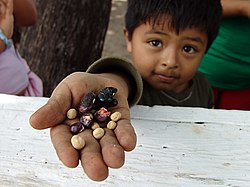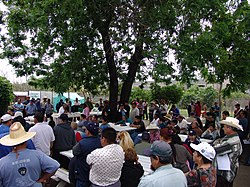South Central Farm: Difference between revisions
→History: + Daryl Hannah still there |
No edit summary |
||
| Line 3: | Line 3: | ||
[[Image:South_Central_Farm_2.jpg|thumb|250px|One of many banners on and around the fence of South Central Farm]] |
[[Image:South_Central_Farm_2.jpg|thumb|250px|One of many banners on and around the fence of South Central Farm]] |
||
The '''South Central Farm''', also known as the '''South Central Community Garden''', is an [[Urban area|urban]] [[farm]] and community [[garden]] located at East 41st and South Alameda Streets in industrialiezed [[South Los Angeles|South]] [[Los Angeles, California|Los Angeles]], [[California]] (formerly known as South Central Los Angeles). At 14 [[acre]]s (~0.056 km<sup>2</sup>), it is the largest [[Urban agriculture|urban farms]] in the [[United States]]. At five a.m. on June 13, the farmers were forcibly evicted. |
The '''South Central Farm''', also known as the '''South Central Community Garden''', is an [[Urban area|urban]] [[farm]] and community [[garden]] located at East 41st and South Alameda Streets in industrialiezed [[South Los Angeles|South]] [[Los Angeles, California|Los Angeles]], [[California]] (formerly known as South Central Los Angeles). At 14 [[acre]]s (~0.056 km<sup>2</sup>), it is the largest [[Urban agriculture|urban farms]] in the [[United States]]. At five a.m. on June 13, the farmers were forcibly evicted. According to NBC news reports Daryl Hanna remianed in a tree with another portester despite the arrests of other protesters. As of 9:P29 PST she had not been removed. |
||
[[Image:South Central Farm NASA 1.png|thumb|250px|South Central Farm Seen from an elevation of 10km.]] |
[[Image:South Central Farm NASA 1.png|thumb|250px|South Central Farm Seen from an elevation of 10km.]] |
||
Revision as of 16:43, 13 June 2006
This article documents a current event. Information may change rapidly as the event progresses, and initial news reports may be unreliable. The latest updates to this article may not reflect the most current information. |

The South Central Farm, also known as the South Central Community Garden, is an urban farm and community garden located at East 41st and South Alameda Streets in industrialiezed South Los Angeles, California (formerly known as South Central Los Angeles). At 14 acres (~0.056 km2), it is the largest urban farms in the United States. At five a.m. on June 13, the farmers were forcibly evicted. According to NBC news reports Daryl Hanna remianed in a tree with another portester despite the arrests of other protesters. As of 9:P29 PST she had not been removed.
History
Before the creation of the garden, the land belonged to nine different owners the largest of which was Alameda-Barbara Investment Company, a real-estate firm which purchased its share in 1980. The company held 80% of the property that would become the present urban garden. [1] The city of Los Angeles acquired the land, by eminent domain, in 1986 for the purpose of building a waste-to-energy incinerator known as the Los Angeles City Energy Recovery Project. This idea was abandoned due to community opposition, led by Juanita Tate and Concerned Citizens of South-Central Los Angeles.
Following the 1992 riots, the City of Los Angeles set the land aside for use as a community garden. In 1994 it contracted with the Los Angeles Regional Foodbank to operate the property as a community garden.
Nine years later, on August 13, 2003, the city council sold the property to Ralph Horowitz, one of the former owners of the property, for $5,050,000 . [2] The City Council discussed and approved the terms of the settlement in closed session. Shortly thereafter the Los Angeles regional Foodbank abandoned the project. In response the farmers formed an organization calling themselves the 'South Central Farmers Feeding Families.'
On January 8, 2004, Horowitz issued a notice to the gardeners setting February 29, 2004, as the termination date for the community garden. In response members of the South Central Farmers Feeding Families obtained legal counsel (Hadsell & Stormer, Inc., and Kaye, Mclane & Bednarski LLP) and filed a lawsuit seeking to invalidate the sale of the property. The Los Angeles County Superior Court issued a temporary restraining order and later a preliminary injunction halting development of the property until the lawsuit could be settled. The farmers lost the lawsuit.
Horowitz sought $16.3 million for the property, more then three times the price he paid for it two years ago.[3] In a deal brokered in cooperation by The Trust for Public Land, the SCF have succesfully raised a little over six million dollars. Fundraising efforts continued as farmers and celebrites have begun both a tree sitting campaign and occupation of the land, while under the threat of forced eviction by the Los Angeles County Sherrif Department. [4]
On June 7, 2006, the Annenberg Foundation announced that they would donate the money to buy the farm. Horowitz, however, did not respond to the offer, since it came after his May 22 deadline.[5]
At three a.m. on the morning of June 13, the Los Angeles County Sheriff's department arrived at the farm, fully surrounding it by four a.m. At five a.m., the sheriffs entered the farm, giving the occupants 15 minutes to evacuate. At that point, most of the occupants of the land left, with a few verbal skirmishes reported. Authorities permitted neither press nor attorneys to enter the farm. Approximately 20 people chained themselves together to resist the eviction. Helicopter photography revealed that the sheriff's department was using high-powered saws to break the chains, and Daryl Hannah has yet to be removed from the walnut tree used as a lookout point.
Plant life (Biodiversity)



The SCF contains an estimated 100 to 150 species of plants (37 of which have been identified by Dr.Devon G. Peña professor of Anthropology at the University of Washington, Acequia Institute) According to Dr. Peña the inventory of plants present at the farm represent its connection to Mega-Mexico, a Vavilov center, one of the original Anthropological locations where plants were domesticated. This Vavilov center stretches from the southern end of Mexico (Chiapas) up to South-Western United States. Some of the plants present have been reintroduced to the area by the farmers, decendents of the original inhabitants of Meso-America. The relationship between the farmers and the plants is not like modern farming. Many plants that are seen as weeds by modern farmers have multiple uses to immigrant farmers. These plants function as crops, herbal medicine, spiritual use, and/or as companion plants.
- Avocado
- Banana
- Bean
- Butterfly plant
- Cactus
- Calabash
- Chamomile
- Chamomile
- Chayote
- Chiplin
- Chokecherry
- Dwarf nettle
- Floss silk tree
- Green amaranth
- Guava
- Husk tomato(ground cherry)
- Jimsonweed
- Maize, corn
- Malabar gourd (a.k.a. Fig-leaved gourd)
- Mallow, cheese flower
- Mexican honeysuckle
- Mexican Parseley
- Mexican tarragon
- Pipicha
- Purslane; pigweed
- Pot marigold
- Red Aztec spinach
- Rootbeer plant
- Rose
- Sapodile
- Seepweed
- Silver wormwood
- Small tallowtree
- Snake Plant
- Spurred anoda, Alfafa:buffalo herb; Lucerne
- Succulents
- Sugarcane
- Tomato
- Wormseed
- Yerba mora
The Farmers

The South Central Farmers consist of approximately 350 poor families from the neighboring community. They are a self-governing organization. This group has transformed the property from a junk filled space into one of the largest urban gardens. Since the notification of the impending destruction of the garden, the group has become politically active and have gathered supporters in politics, higher-learning, entertainment, and abroad.
The operating framework of of the SCF is made made up of elected roles recruited from the General Assembly of the farmers. Some of these positions, are publically visible representatives of the SCF, such as Rufina Jaurez and Tezozomoc. These two "voices" are often mistaken for the organization's leaders, because they often need to interact with the outside public. All roles taken by members of the SCF exist soley to fulfill a need or set of needs to continue the healthy life span of the farm. On the farm women fullfill a majority of the roles from accounting to that of lot monitors.
Notable supporters
- Joan Baez, activist and folk singer
- Michael 'Flea' Balzary, of the Red Hot Chili Peppers writing in his Fleamail
- California Green Party
- Zack de la Rocha, lead singer of Rage Against the Machine
- Dr. David Diaz, Professor of Urban Planning at Cal State Northridge
- Leonardo DiCaprio
- Danny Glover, actor
- Daryl Hanna, actress
- Julia "Butterfly" Hill, environmental activist
- Immortal Technique, Hip hop musician
- Ron Kovic
- Tom Morello, of Audioslave and Rage Against the Machine
- Ralph Nader, activist
- Willie Nelson, singer
- Daniel Ortega, Professor of Architecture at UNLV
- Ozomatli
- Dr. Devon G. Peña, Professor of Anthropology University of Washington, The Acequia Institute
- Leslie Radford, Los Angeles Independent Media Center.
- Alicia Silverstone, actress
- Antonio Villaraigosa, Mayor of Los Angeles
Critics
- Ralph Horowitz, developer
- Dennis P. Zine, Los Angeles City Councilman
- Former South Central Farmers [6]
See also
- Chávez Ravine
- Chicano Park
- Environmental racism
- Eminent Domain
- Food security
- Indigenous peoples
- People's Park, Berkeley
- Permaculture
- Property
- urban agriculture
References
- Bushel of Complaints, Daniel Hernandez,David Zahniser (contributer), LA Weekly, Tuesday, 21 March 2006.
- Councilman Zine Issues Statement Regarding South Central Farm Incident.
- “Deal to Buy South L.A. Community Garden Running Short on Time”, Steve Hymon, Los Angeles Times, May 20, 2006.
- 14 Acres-Conversations Across Chasms in South Central Los Angeles, Jessica Hoffmann, Christine Petit, et al. Clamor magazine, issue 36, spring 2006.
- Farmers Feeding Families: Agroecology in South Central Los Angeles, Dr. Devon G. Peña, Professor of Anthropology, University of Washington, Acequia Institute Acequia Institute, Lecture presented to the Environmental Science, Policy and Management Colloquium, University of California – Berkeley, October 10, 2005.
- "The Future at War with the Past", Jamey Hecht, FromTheWinderness.com, 2006.
- Insult to Injury, Front Lines, Los Angeles City Beat, Perry Crow,March 30, 2006.
- "L.A. Urban Farmers Fight for Community Garden", Jessica Hoffmann, The New Standard, April 5, 2006.
- "No Place to Play -- Los Angeles Parks Report", The Trust for Public Land, November 2004.
- "Preliminary List of Botanical Species Grown At South Central Community Garden". Dr. Devon G. Peña, Tezozomoc.
- "Owner Threatens to Raze Garden in Industrial L.A.", National Public Radio.
- "Seeds of Dissension Linger-Farmers in the South Central Community Garden decry the loss of the land to a warehouse project. Some plan to resist the bulldozers.", Erika Hayasaki, Los Angeles Times, October 31, 2005.
- The South Central Farmers Official website.
- South Central Farm photos on wikimedia, Jonathan McIntosh, photographer.
- "Tezozomoc: The organizer with South Central Farmers on surviving eviction, feeding the poor, and rethinking city parks" Dean Kuipers, Los Angeles City Beat, April 21, 2005.
- "Third-space Farmers", Devon G. Peña Ph.D., Vision Magazine Catalyst for Conscious Living, Nov 5. Available at: http://www.visionmagazine.com/11_05/la.htm.
- "Until the Farm is Secure" Leslie Radford, Los Angeles Independent Media Center, May 27, 2006.
- "Deputies Begin Evicting South L.A. Farmers", CBS2.com, June 13, 2006.
Further reading
- "The Effect of Community Gardens on Neighboring Property Values" Vicki Been and Ioan Voicu, NYU Law and Economics Research Paper No. 06-09, March 2006
External links
- Google Earth community Link To SCF
- The Trust For Public Land
- USDA Plants Database
- South Central Farm Flickr group
- Save the Farm Blog
